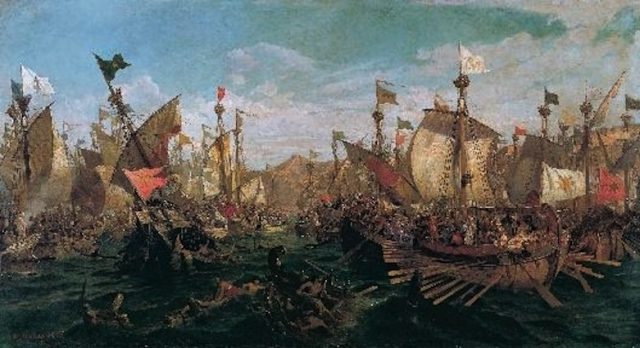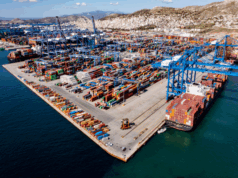2,500 years ago, this week in September of 480 B.C. the Greeks defeated the Babylonian-Persian Empire
In the Naval Battle of Salamis…the winds helped a little!
 By: Professor Christos S. Zerefos
By: Professor Christos S. Zerefos
Head, Research Center for Atmospheric Physics & Climatology, Academy of Athens, Greece
Christos S. Zerefos is a Greek physicist, born and raised in Cairo, Egypt. He finished the Greek Ambetios High School in Cairo and moved to Athens for his University studies. He graduated in Physics and obtained a MSc in Meteorology and a Ph.D. in Physics-Meteorology from the University of Athens.
In 1979 he became director of the Atmospheric Physics Center of the Academy of Athens, and at the same time he was elected professor of atmospheric physics at the University of Thessaloniki. In 2002 he became f Professor of Geology at the University of Athens.
Professor C. Zerefos has coordinated in numerous international competitive research projects, funded by International Organizations (European Union, NASA, WMO etc.) or national sources. In December 2006 he was elected a Full Member of the Academy of Athens, Greece.
- Introduction:
September 2020 marks the anniversary for the 2500 years that have passed since the famous naval battle of Salamis, which took place in late September 480 B.C. That titanic naval battle historically represents the clash of two major civilizations, namely the Hellenic and the Babylonian-Persian. The knowledge of seasonal winds and local climatology by the Greek admirals was used effectively in their strategic plans. Aristotle describes these winds, their timing (after the summer solstice) and their strength with great accuracy. The ancient Greeks were aware of such local climatologies which are remarkably similar even today, 25 centuries later.
It is worth presenting a brief historical background on events before the naval battle at Salamis. This description is based on all available ancient sources regarding the weather conditions during the Persian invasion in Greece. The spark that started the flame of the Persian invasion in Greece can be traced back to the Ionian Revolt in 499 B.C. when Greek colonies in Asia Minor rebelled against the Persian rule and both Athens and Eretria supported their uprising. This action led the Persian king, Darius, father of Xerxes, to seek revenge from Greece. The first attempt which took place in 492 B.C. led by the Persian General Mardonius turned into a disaster, since almost all of his fleet sank in a severe storm off the shore of Mount Athos, in Macedonia, North Greece. The second attempt took place in 490 B.C. under the command of the Persian Admiral Datis and Persian General Artaphernes. Their defeat in the battle of Marathon in 490 B.C. is well known and celebrated globally during the Olympic Games.
After their defeat in Marathon, the Persians postponed their preparations to invade Greece for almost nine years. This postponement was due to both the rebellion of Egypt and the need to expand the volume and power of the Persian forces. It was decided by Xerxes, now the young Persian king, that the third attempt to invade Greece should take place inland, rather than at sea, by bridging Hellespont from Abydos to the opposite shore of Sestus in the spring of 481 B.C. The bridging failed on account of a storm, which destroyed whatever Xerxes’ engineers had made. The storm, which dismantled the construction, must have been accompanied by gale-force winds. According to Herodotus, the solution was to place three hundred and sixty ships connected side-by-side so that they would make up a bridge, over which the Persian army finally managed to cross into Europe in the spring of 480 B.C.
Subsequently, the Persian marine and land forces met at the Evros estuary and Xerxes himself inspected the fleet. The triremes counted were one thousand two hundred and seven, while the total of the rest of the ships amounted to three thousand. The Persian fleet sailed in parallel to the advancing land troops, until they reached the Axios estuary at the Thermaic Gulf, where all Persian land forces gathered. The Greeks, in their attempt to intercept the Persian invasion, decided to occupy Thermopylae with their land forces, and Artemisio with their fleet. Eleven days after the Persian fleet had set sail from the Thermaic Gulf, it arrived at the coast of Magnesia. The next day, gale-force northeast winds brought about very heavy seas which lasted for three days. It is estimated that three hundred triremes and dozens of smaller ships were lost, while larger vessels were carried away by the winds and the heavy seas to the coasts of Pelion. It is obvious that the disaster caught the Persians off guard and, in panic, those of them who survived set sail to the southeast end of Magnesia, where they anchored in the Pagasetic Gulf.
The Greeks, who were informed by the day scouts about the Persian fleet damage, returned at the highest possible speed from Chalkis to Artemisio, so that they would arrive there earlier than the Persian ships. As a matter of fact, they also captured fifteen of them. Another two hundred Persian ships attempting to circumnavigate Euboea were lamentably wrecked at Cape Kafireas. At the same time the Greek army was defeated at Thermopylae and the Greek fleet set sail south to protect the southern regions. The Persian fleet anchored in Artemisio and they stayed there for several days, during which their land troops were passing through Thermopylae, so that at the demand of King Xerxes, the entire army would be able to see the fallen Greeks at Thermopylae on their way to Athens. When the Persians arrived in the city of Athens, which was completely destroyed, their fleet must have numbered about one thousand ships, whereas the corresponding Greek fleet comprised around three hundred.
The intention of the Greek commanders was to bring the conflict in the Salamis Channel because, according to Herodotus: “to fight in the narrows is to our advantage, but to fight in open waters is to their advantage” The advantages included the narrow front, the Greek hoplites on the shore that would cover their right flank, and the Persian fleet that would have to enter the relatively confined vestibule between Cape Cynosoura and Attica coast to the north. To lure them into the narrows, Themistocles, commander of the Greek forces, sent his messenger, Sicinnus, to deliver a misleading message to King Xerxes. Sicinnus reported that the Greeks were demoralized and considering flight and his words were taken by Xerxes to be true. Upon this news and during the night hours, Xerxes sent a detachment to the deserted island of Psitalia to close the narrows between Salamis and Megara and finally, the main fleet to block the eastern exits. At dawn, he would attack what he considered to be the remaining Greek fleet.
Historians determine the date of the naval battle of Salamis between the 25th and 30th September, 480 B.C. The most prevalent weather type during September in Salamis is either that of the sea breeze or a combination of the annual winds with the sea breeze. At the end of September, there is, of course, a slight probability of rainfall or even a chance of a summer storm during the early afternoon hours. However, Aeschylus, the dramatist who fought in the Battle of Salamis and wrote “Persians” when back in Athens, mentions that there was sunshine on the morning of the sea battle, which leads us to the exclusion of any other type of weather except that with a sea breeze or/and with an annual wind, usually observed, when the sky is clear.
- Before the Battle:
The local sunrise at the end of September is at about 07:00–07:10 LST. Herodotus and Aeschylus stated that the battle had commenced at dawn. Although maneuvers may have begun at dawn, the actual battle did not, due to the time needed for ship preparations, the gathering of the troops, the admiral and commander speeches and the embarkation of the crew on the ships. Hammond, the author of The Battle of Salamis, estimated the approximate timing of the battle and reached the conclusion that at least two and a half hours were needed for the Persians and two hours for the Greeks to deploy and reach their battle positions. During the early morning hours, the prevailing wind blows off shore, and comes down the Salamis Channel as a north-westerly or westerly flow, raising no sea. This is also supported by Hammond, who indicated that the sea was calm enough in the Channel of Salamis for the Persian fleet to advance under oar and for the Greeks to muster and advance under oar and sails. This is the time when the Greek paean marks the beginning of the Greek attack.
- During the Battle:
The Persian fleet moved on against the Greek fleet which at that time was ordered to roar astern yet always keeping the prow towards the Persian fleet. Themistocles’ tactics was on one hand, to attract the Persian fleet in the narrower place and to impel them to fight there and second, to gain time for the wind to rise, as Themistocles had been anticipating from the local wind climatology. This operation would require an additional half an hour or more. Taking into account that the local dawn at this time of the year is at 07:00 LST, we come to the conclusion that the commencement of the battle could not have started earlier than10:00 LST. This is the time when, according to Plutarch, Themistocles “made sure that he would not send his triremes bow on against the Persian vessels until the hour of the day had come which always brought the breeze fresh from the sea”. Indeed, at around 10:00 LST the change in wind pattern is evident and the southerly sea-breeze starts affecting the Salamis Channel.
The Greeks were aware and in anticipation of these changes in the local wind conditions. As described by Plutarch, the sea breeze had minor effects on the smaller Greek ships due to their shorter bows and sterns. In contrast, the taller Persian ships were severely affected by the increasing winds since these could not easily steer and thus became more vulnerable to being rammed by the Greek ships. Herodotus writes that according to the accounts of the Athenians, on the morning of the sea battle, the Corinthians, panicking at the sight of the enemy, set sail and left hastily. He also adds that the Corinthians did not only refute the Athenians’ accusation, but on the contrary they claimed that their move was made to cover the rear of the Greek fleet in case of a counterattack by the Persian squadron, which had already cut off the retreat path of the Greek fleet. Anyway, setting sail towards the northwest exit of the channel would have been possible only with a southeast sea-breeze flow.
4. Conclusion
The ancient Greeks were aware of these climatological wind patterns, which last from May to September. According to Aristotle, the precursors of the Etesians, “prodromoi”, start in May while the late Etesians, “metoporoi”, last until the end of September. The end of September, when the sea-battle of Salamis took place, is a borderline period when the Etesians start weakening but the sea breeze still continues to develop in the Saronic Gulf due to the high thermal gradients between land and sea. In September, the sea breeze starts as early as 10:00 LST and continues strengthening up to six meters per second until sunset, when it is replaced by the west-northwest winds of the Etesian regime at nighttime. Themistocles took advantage of the local winds which favored the Greek fleet, while in the course of the day the Persian fleet was trapped by the change of the wind inside the narrow channels of Salamis Straits. Our findings are in concurrence with the accounts by ancient writers. The situation, hour-by-hour, can be described as follows:
The sea-battle in Salamis most probably started about two hours after sunrise. The Persian fleet took battle formations under full daylight and they were taken by surprise at the sound of the Greek war song (paean), “Advance, ye sons of Greece, free your country, free your wives, your children, the temples of your gods and the sacred tombs of your ancestors, now the fight is for all of them”, (from Aeschylus play “Persians”), the trumpet and the leading Greek vessels. Themistocles then ordered the Greek ships in the right wing and right center to reverse their course triggering the Persian ships to invade by entering further into the narrow straits of Salamis. The Greek ships started moving backwards, rowing in retrograde while they maintained their prows steadily facing the enemy. In this way, the encounter of the two fleets in the middle of the straits was averted and valuable time was gained until the change of the wind expected to turn to southerly directions took place at around after 10.00 LST. According to Plutarch, “Themistocles was well aware of the local wind climatology at Salamis, so this was the reason why he made sure that the Greek ships were lined up opposite the Persian ones at the specific time when a strong wind blew from the sea bringing waves to the straits”. He continues by saying that “while this wind would not harm the Greek ships which were low and did not protrude much from the sea, it would afflict the Persian ships that had upright sterns and high decks and it would turn them sideways to the Greek ships, thus rendering the former more vulnerable to ramming”. The Persian ships were unaware of the phenomenon and they were caught off-guard, whereas the Greeks got an important operational advantage. Ramming and destruction continued to result in great damage to the Persian fleet which was trapped by the breeze. The breeze continued strengthening towards the noon and afternoon hours, inhibiting the Persian ships from setting sail and escaping towards the open sea. Instead, the Persian fleet was pushed into the narrow straits of Salamis where it was almost completely destroyed by the Greek ships in the early evening hours.
Themistocles was aware of the prevailing wind patterns on the battle. In the war council that took place before the battle and during an ongoing dispute regarding the day of the battle, following strategic moves of the Greeks, he said the famous phrase to the Spartan admiral Evriviades: “πάταξoν µέν, ἄκoυσoν δέ”. The broad meaning of this phrase is “hit me, but first listen to me” and it shows Themistocles’ determination to battle against the Persian fleet at that particular location following the previously described strategic plan. Of course, there were a number of political reasons affecting Themistocles’ decision to stay at Salamis, such as the proximity of Salamis to Athens and the existence of Athenian refugees and troops on the island. However, his knowledge of the local wind climatology in combination with the narrow straits must have been the critical argument that tilted the balance in the Greek council of admirals towards confronting the Persian fleet in the straits of Salamis. So, we can describe the variation of the wind in the Saronic Gulf as an “invisible pincer” of air blowing from west-northwest at night and early in the morning being replaced by a southeast wind after 10.00 A.M. and through early evening. The formation of this local pincer trapped the Persian fleet in Salamis and led to one of the greatest victories in history.
- This article is taken from an open access article titled: “Zerefos, C.; Solomos, S.; Melas, D.; Kapsomenakis, J.; Repapis, C. The Role of Weather during the Greek–Persian “Naval Battle of Salamis” in 480 B.C.. Atmosphere 2020, 11, 838.” and it is distributed under the terms and conditions of the Creative Commons Attribution. (CC BY) license (http://creativecommons.org/licenses/by/4.0/).
- The full article with references, bibliography, maps etc. is available here: https://www.mdpi.com/792510












